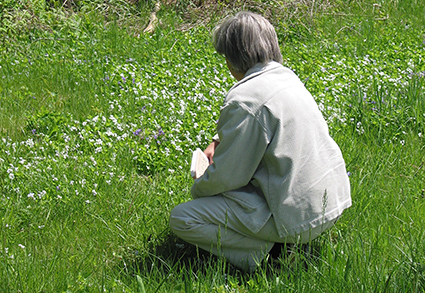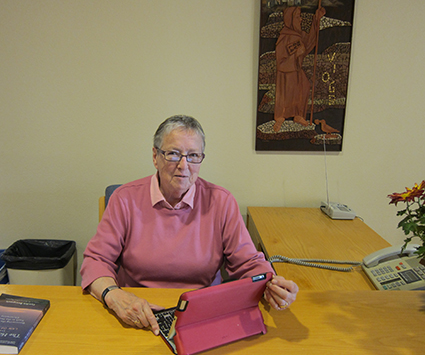
A retreatant meditates on the grounds of Holy Wisdom.
Were he present today Siddhartha Gautama, the Buddha, would applaud Holy Wisdom Monastery, a setting where one finds peacefulness and an aura of centeredness, an ideal setting in which to deepen one’s practice of mindfulness meditation.
Over 2,500 years ago the Buddha arrived at a doctrine and discipline for exploration which has become the path of practice leading to liberation from suffering and stress. Better said, perhaps, leading to a peacefulness and clarity of mind.
The Buddha never claimed to be a God. There are no vows, no creeds or dogma, and his teachings are not a religious practice. Comparisons are best made with western psychology which follows a medical model of identifying an illness and a treatment.
Mindfulness meditation offers precepts and tools for self exploration in the belief that each individual has the power and the means within to attain a level of disciplined behavior based on self knowledge. The practice leads us to examine our core beliefs about ourselves, who we are, and how we can learn different behaviors as an avenue to a disciplined, responsible and ethical life.

Jane Ayer, author of this article, volunteers weekly at the front desk in either the monastery or retreat and guest house.
The nature of Holy Wisdom Monastery is a seemingly perfect setting for the practice of meditation. The buildings themselves provide the basic spiritual values of simplicity and solitude, and bring about an encounter with our deep feelings of reflection and solitude. By its nature, the setting invites us to a respectful observance of the Rule of Benedict, with its emphasis on prayerful hospitality and mindful stewardship of the land.
A beginning goal of meditation is to focus on the breath as a means of clearing the mind of the many random thoughts which flow through without invitation and, often, with no rhyme or reason. This bothersome state is called “monkey mind.”
The beginning steps ask us to detach ourselves from these thoughts and to instead focus on the breath; the in and out of breathing, the temperature of the breath, and where you sense its presence in your body. To describe the process seems so simple. However, after practicing this simple sounding technique the real work begins.
The Buddha was great for compiling lists, hundreds of them actually. Primary to practice is the Eightfold Path which defines key behaviors for perfection leading to an enhanced discipline. It is at this phase of practice where the monastery enters the picture. Concentration is a key to meditation practice; the bucolic setting and the Benedictine values found at the monastery are natural accompaniments to the refinement of one’s practice.
When approaching the monastery from the drive into the property one can sense immediately the enfolding aura of tranquility and receptivity to all who enter here. In my many excursions to meditation “sittings” in various locations throughout the country, I have found no equal to the setting and positive reception in support of my practice than at Holy Wisdom.
The monastery has hosted many groups and organization-sponsored retreats. It also has fine accommodations for individual retreatants, including private overnight rooms in the retreat and guest house and the hermitages for those who wish a more total isolation and uninterrupted concentration.
The exploration of the many factors identified by the Buddha are best pursued in a small study group called a Sangha. Many such groups have come to the monastery where concentrated attention to practice is made possible by the respectful arrangements offered by the staff.
It is a strange experience to observe 40 practitioners walking about in silence and even eating in silence for several days as we develop our tools for ethical and moral living, a life-long way of being.
Mindfulness meditation is a journey with no end. The journey becomes the goal as we attain ever deeper and changing levels of self realization, and as we achieve clarity and serenity. For many, Holy Wisdom Monastery and the Benedictine way have become key factors in this study.

